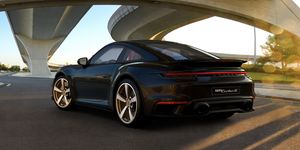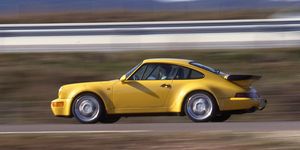It’s happened before, but it’s been a while. You see, C/D testers tend to acclimate to hard acceleration. Seat time in Teslas, Ferraris, Lamborghinis, and AMGs will do that. Our inner ears take so much violent g-force abuse that even monstrously quick begins to feel perfectly normal.
Just over the Los Angeles River, east of Hollywood, there’s a two-lane straight about an eighth of a mile long that feeds into a left-right entrance ramp onto the CA-2. That road heads up the mountain toward La Cañada and Angeles Crest. If the ramp is empty, you get a couple seconds at full throttle as you dash toward the banked ramp. In most cars, navigating that takes a light dab of the brakes while downshifting before turning onto the ramp and merging with authority. On that short straight, we hit the accelerator on the 2021 Porsche 911 Turbo S and then glanced down at the speedometer. We were going 94 mph.
A few thoughts crashed the moment, beginning with: Oh, this is a German-market 911, and Porsche forgot to change the digital speedo from kilometers to miles per hour, because there’s just no way that reading is accurate. Then: No, wait. It’s not a mistake, these are mile readings, and they’re about 30 mph higher than we anticipated. Like we said, we’ve seen this before. But that was more than a decade ago, and we were in a Bugatti Veyron.
Maybe if we’d paid a little closer attention to the materials that Porsche sent us instead of just getting in and driving, we’d have been a little better prepared. Here’s what we should have known: The new Turbo S has 640 horsepower and 590 lb-ft of torque, improvements of 60 horses and 37 lb-ft over the outgoing model. Providing that bump is a heavily revised version of Porsche’s twin-turbo flat-six that shares its basic architecture with the 3.0-liter engine in the workaday Carrera and Carrera S models.
Although it’s a new family of engines, the new Turbo’s flat-six has the same bore dimension as before, while a slightly shorter stroke drops its displacement to 3.7 liters, compared with 3.8 on the previous-gen Turbo and Turbo S. But not to worry, as there’s more than enough boost to make up for it—22.5 psi, in fact. The intercoolers are 12 percent larger and are fed cooling air more efficiently than before, through both the nostrils in the rear fenders and by two large vents in the rear decklid. The intercoolers do a better job of chilling the pressurized air created by the two new symmetrical turbos.
Larger than before, the new turbos are also identical twins. Well, they’re mirror images of each other, the goal being an equal and quicker response from each turbocharger. Both are fed up by a cast exhaust manifold heavily inspired by the ones used in the last-gen GT2 RS. There’s really nothing like lag happening here. Even in its weakest moments, this engine is a blink away from burying your shoulder blades into the Turbo S’s seat backs. What you hear is the mechanical grit, bellow, and rasp of a flat-six.
We need to slow down, at least a little. The new Turbo S includes standard 16.5-inch carbon-ceramic rotors that are now clamped by 10-piston calipers in front (up from six-piston pinchers). A hard pedal drops the speedometer to reasonable numbers in an instant.
The Turbo (capital T) versions of the 911 have always been the widebody, no-neck punks of the 911 world. The new-generation Turbo’s body doesn’t challenge the order of things. Its front track—the distance between the 255/35R-20 Pirelli P Zero PZ4s—increases by 1.7 inches over the previous Turbo’s. But that wider front end is no different than the new Carrera’s. In back, where the 315/30R-21 Pirellis live, the body is 1.8 inches wider than a regular 911.
When it comes time to turn into the ramp, the Turbo’s wider stance cuts and holds hard. No drama, just cling. Ease into that left to right transition and, whoa, that Civic trundling along in the right lane looks scared. Back on the gas. Unfortunately, we didn’t get to perform instrumented testing, but we guess a skidpad grip near 1.10 g. Your passengers will be shouting for mercy well before you approach this car’s limits.
Our car arrived with the optional PASM sport suspension that drops the car 0.4 inch on higher-rate springs and recalibrated adaptive dampers. On certain bumps, the chassis shot us out of the saddle like a PBR bull. Yeehaw, then ouch. And it happened in the Normal drive mode, not in the more unyielding Sport or Sport Plus settings. Yet, out in the canyons, the Turbo S doesn’t feel abusively harsh. It simply flows from corner to corner, four-wheel steering working its magic, the dampers keeping everything grounded, and the gearbox selecting the right gear before the turn-in into corners.
Like the last 911 Turbo, there’s no manual-transmission option. While having that connection with this engine would bring joy and tears to the air-cooled faithful, we have to admit that with the Turbo S’s acceleration flinging you back, it might be hard to grab the shifter. All Turbo S models come with an eight-speed dual-clutch automatic that allows you to keep your hands on the wheel.
This automatic does have a playful side. To engage play time, switch the knob on the steering wheel to Sport or Sport Plus to activate Porsche’s launch-control system. Stop the car. Hold the brake with your left foot and hold down the accelerator with the right until the engine revs to 5000 rpm. Look as far down the road as you can before releasing the brake, and whooaa. There’s a certain brutality as the blast of an engine turned up to 171 horsepower per liter cranks through the drivetrain and into the road. The tires screech. Passengers screech. Maybe even you screech—at least a little. Bear in mind that the tire squeal happens despite the Turbo S’s standard all-wheel-drive system.
We can hear the lawyers now. Do you suffer from heart, back, or neck trouble? High-blood pressure? Have you or a loved one been exposed to a Porsche 911 Turbo S? If so, call this number. Except Porsche probably has better lawyers than most amusement parks. Sign here, here, and initial here. Have fun.
Porsche claims the Turbo S will bring you to 60 mph in 2.6 seconds. Historically, Porsche’s estimates have been generally conservative—lawyers again—but recently they’ve been getting closer to reality, and we’d be surprised if we beat this one by more than a tenth. But it’s not that initial acceleration that shocked us. Inner-ear toughness and years of 911 Turbos have skewed our cilia and our expectations. What surprised us is how the acceleration just doesn’t let up. There’s the empty freeway ahead. We glance at the speedometer, smile, and dream of an empty autobahn in the summertime. Whoa. Back on the brakes.
Source: Reviews - aranddriver.com








